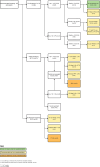Retrospective audit compares screening and treatment of pregnancy-related anaemia in regional New South Wales with Australian guidelines
- PMID: 38961376
- PMCID: PMC11223411
- DOI: 10.1186/s12884-024-06634-5
Retrospective audit compares screening and treatment of pregnancy-related anaemia in regional New South Wales with Australian guidelines
Abstract
Background: Anaemia during pregnancy is common worldwide. In Australia, approximately 17% of non-pregnant women of reproductive age have anaemia, increasing to a rate of 25% in pregnant women. This study sought to determine the rate of screening for anaemia in pregnancy in regional New South Wales, and to determine whether screening and treatment protocols followed the recommended guidelines.
Methods: This retrospective study reviewed antenatal and postnatal (48 h) data of women (n = 150) who had a live birth at Bathurst Hospital between 01/01/2020 and 30/04/2020. Demographic data, risk factors for anaemia in pregnancy, antenatal bloods, treatments provided in trimesters one (T1), two (T2) and three (T3), and postpartum complications were recorded. These were compared to the Australian Red Cross Guidelines (ARCG) using descriptive statistics.
Results: Of the women with screening data available (n = 103), they were mostly aged 20-35yrs (79.6%), 23.3% were obese, 97.1% were iron deficient, 17% were anaemic and only a few (5.3%) completed the full pregnancy screening as recommended by the ARCG while a majority completed only partial screenings specifically Hb levels in T1 (56.7%), T2 (44.7%) and T3 (36.6%). Compliance to oral iron was largely undocumented, but constipation was a common side effect among the women. IV iron was administered in 14.0% of women, approximately 1.75x higher than the recommended rate.
Conclusions: This study provided useful information about compliance to screening and treatment guidelines for anaemia in pregnancy. We identified the need for improved documentation and communication between various health providers to ensure adequate antenatal care to prevent maternal complications during pregnancy. This will improve patient care and encourage further developments in maternal care, bridging the rural health gap.
Keywords: Anaemia; Guidelines; Iron supplements; Pregnancy; Rural.
© 2024. The Author(s).
Conflict of interest statement
The authors declare no competing interests.
Figures




Similar articles
-
Detection & management of anaemia in pregnancy in an urban primary health care institution.Indian J Med Res. 2008 Jul;128(1):45-51. Indian J Med Res. 2008. PMID: 18820358
-
Anaemia in pregnancy and associated factors: a cross sectional study of antenatal attendants at the Sunyani Municipal Hospital, Ghana.BMC Res Notes. 2017 Aug 11;10(1):402. doi: 10.1186/s13104-017-2742-2. BMC Res Notes. 2017. PMID: 28800737 Free PMC article.
-
Challenges in preventing pyelonephritis in pregnant women in Indigenous communities.Rural Remote Health. 2005 Jul-Sep;5(3):395. Epub 2005 Aug 5. Rural Remote Health. 2005. PMID: 16083300
-
[Review by expert group in the diagnosis and treatment of anemia in pregnant women. Federación Mexicana de Colegios de Obstetricia y Ginecología].Ginecol Obstet Mex. 2012 Sep;80(9):563-80. Ginecol Obstet Mex. 2012. PMID: 23243836 Spanish.
-
Revisiting the basis for haemoglobin screening in pregnancy.Curr Opin Obstet Gynecol. 2019 Dec;31(6):388-392. doi: 10.1097/GCO.0000000000000580. Curr Opin Obstet Gynecol. 2019. PMID: 31573997 Review.
References
Publication types
MeSH terms
LinkOut - more resources
Full Text Sources
Medical
Miscellaneous

